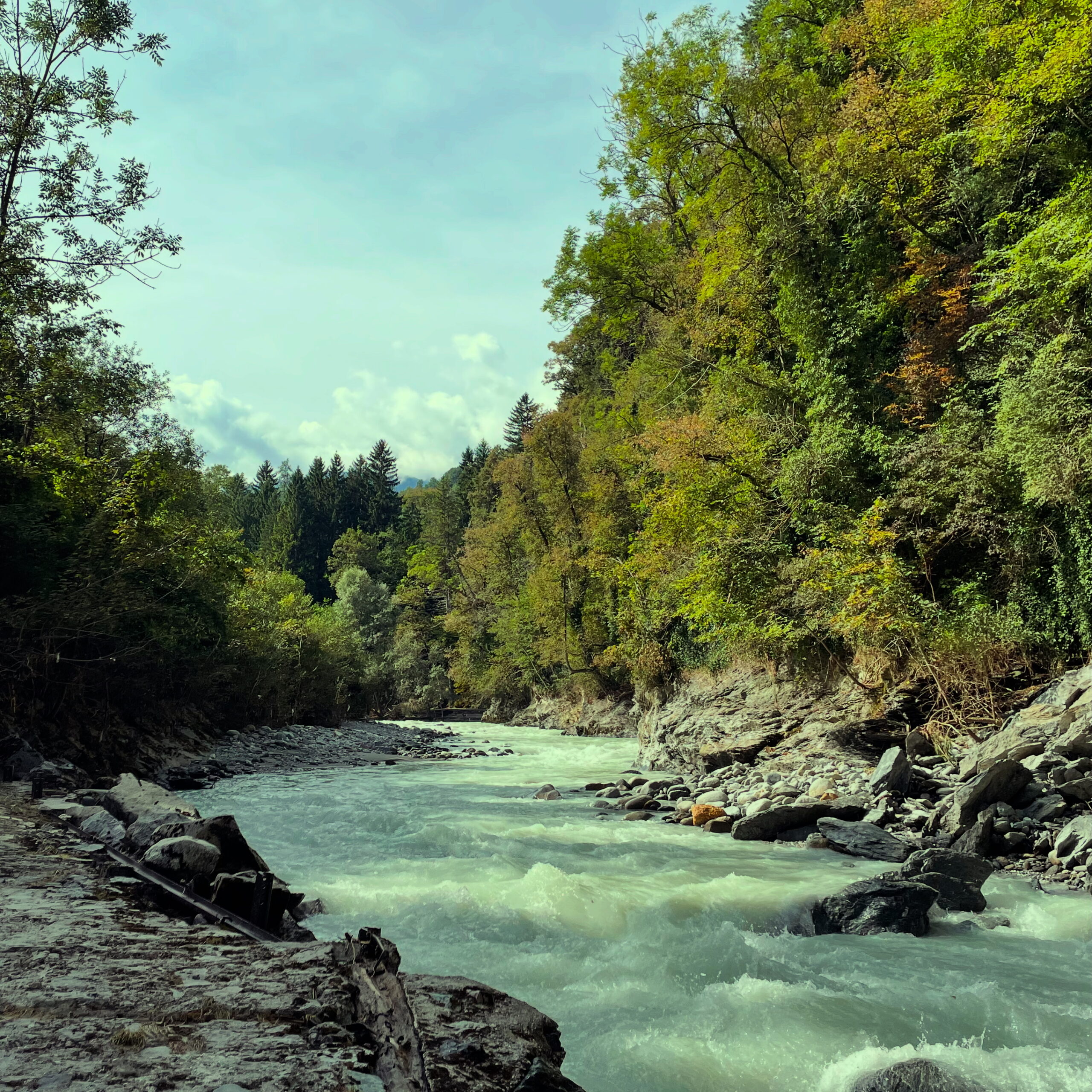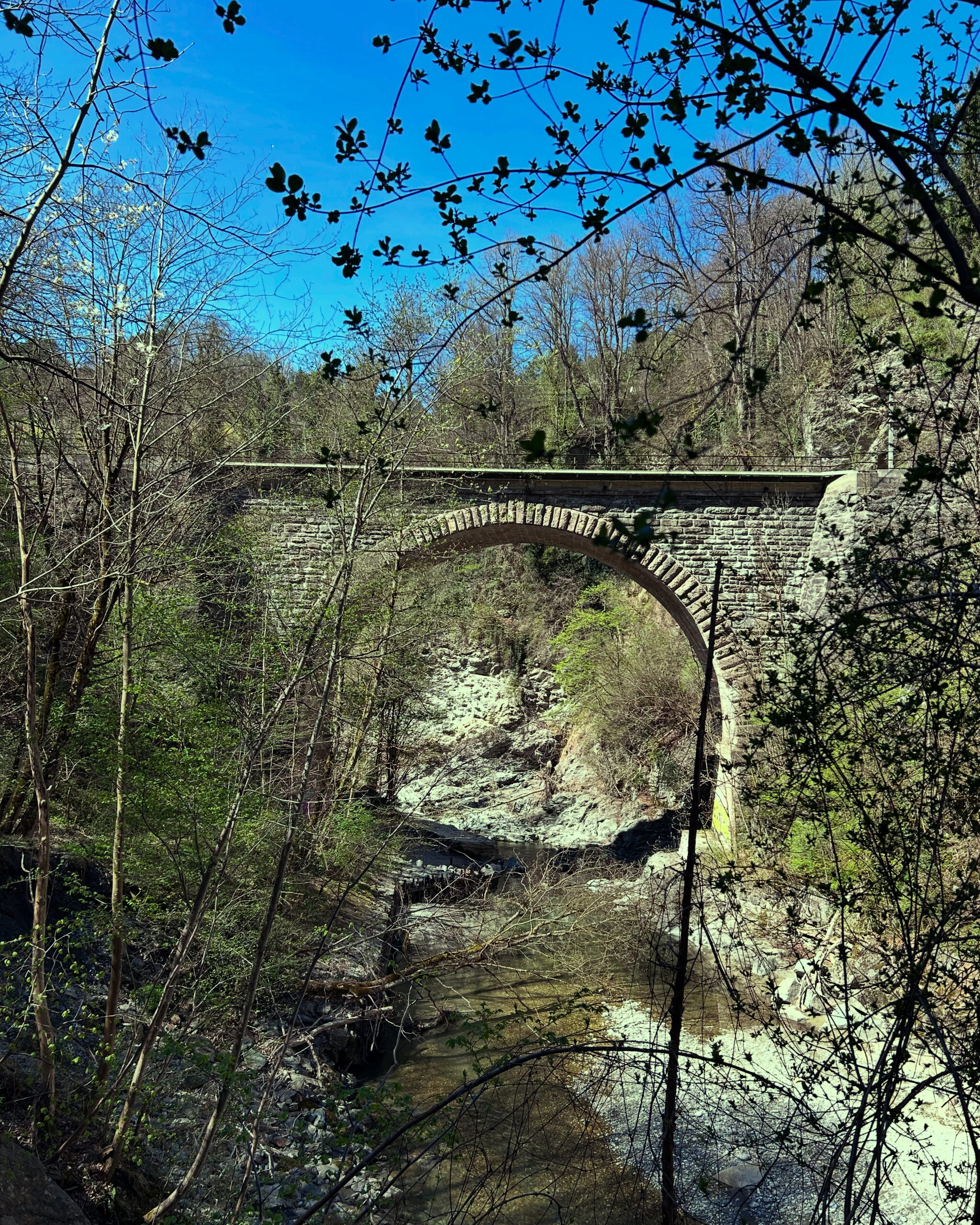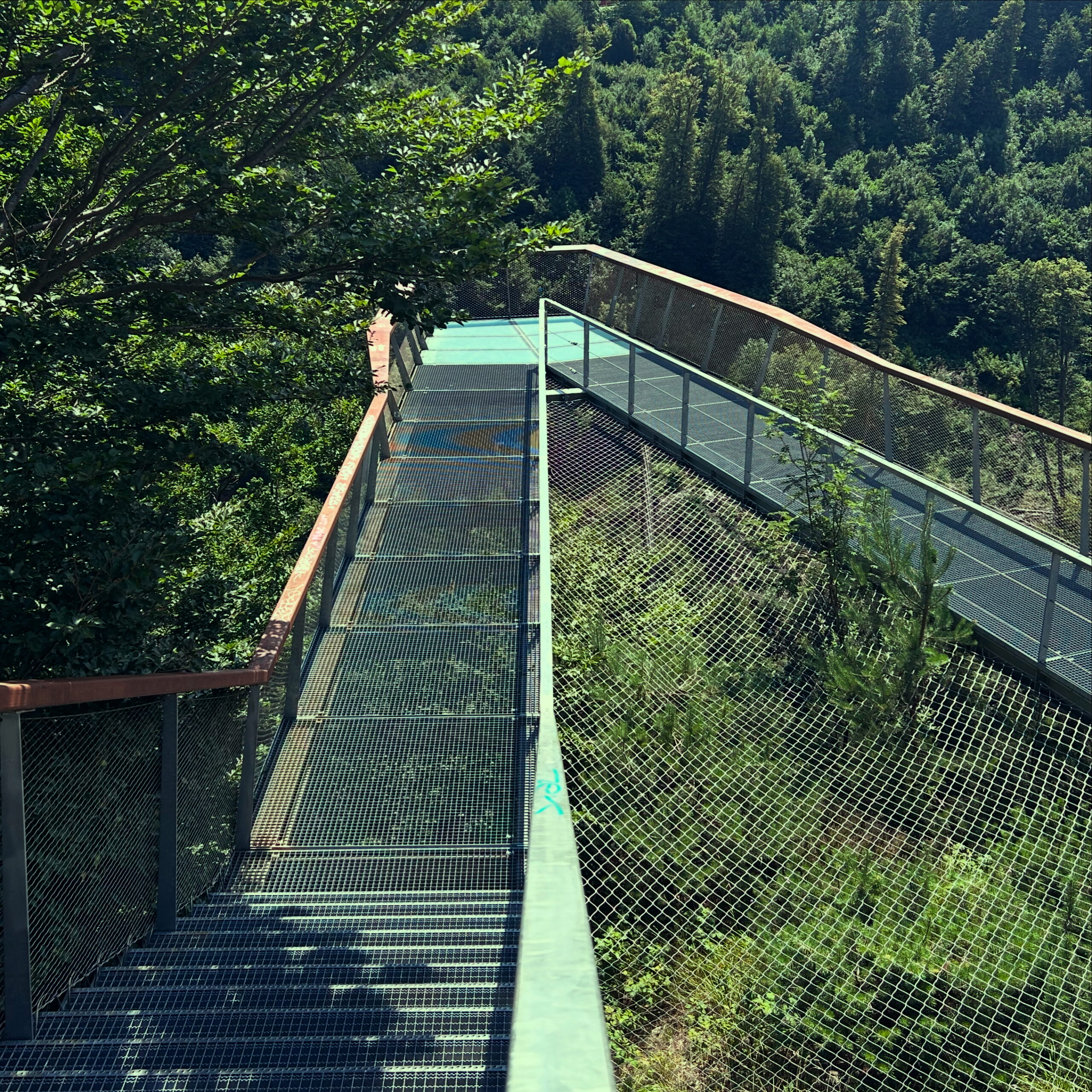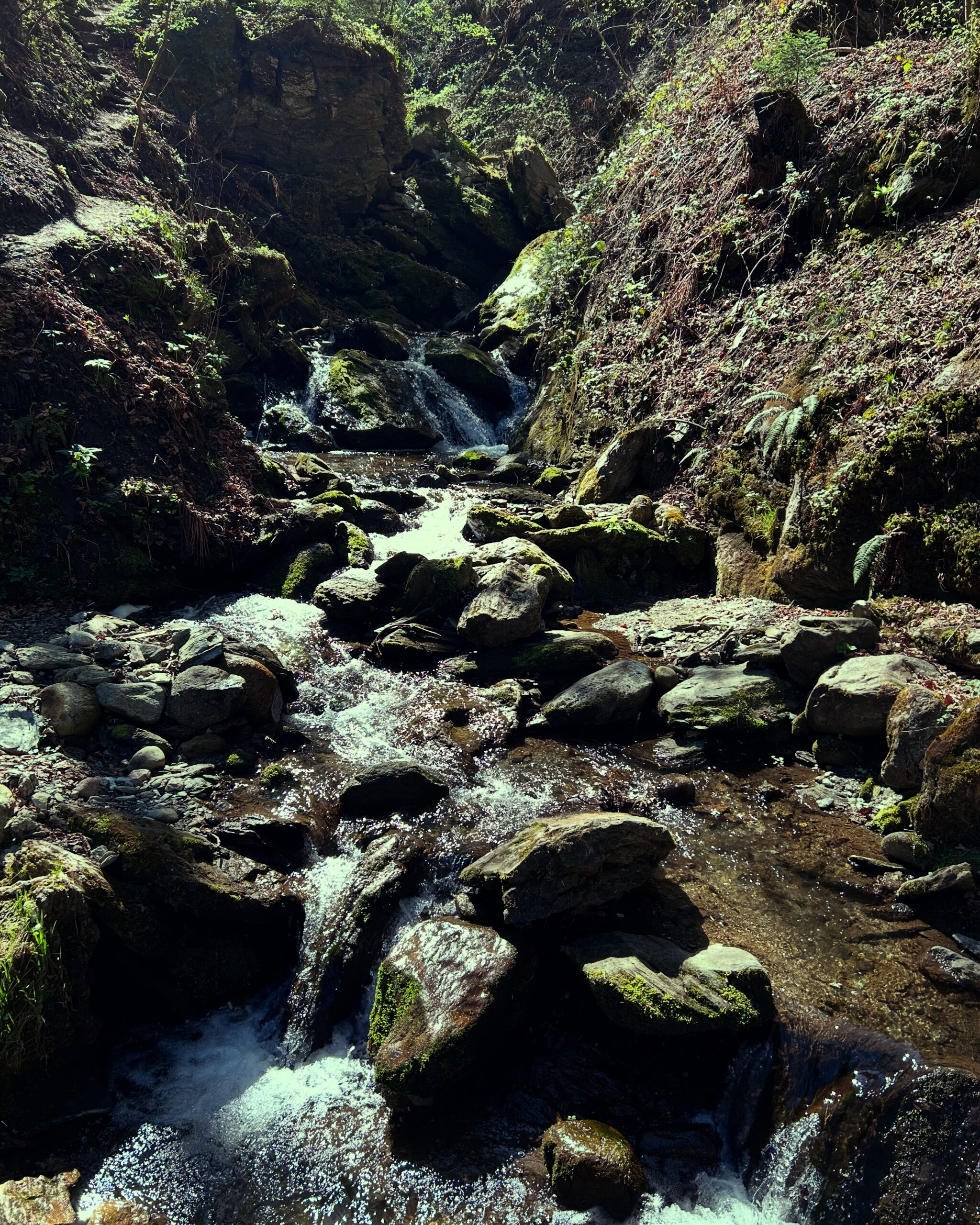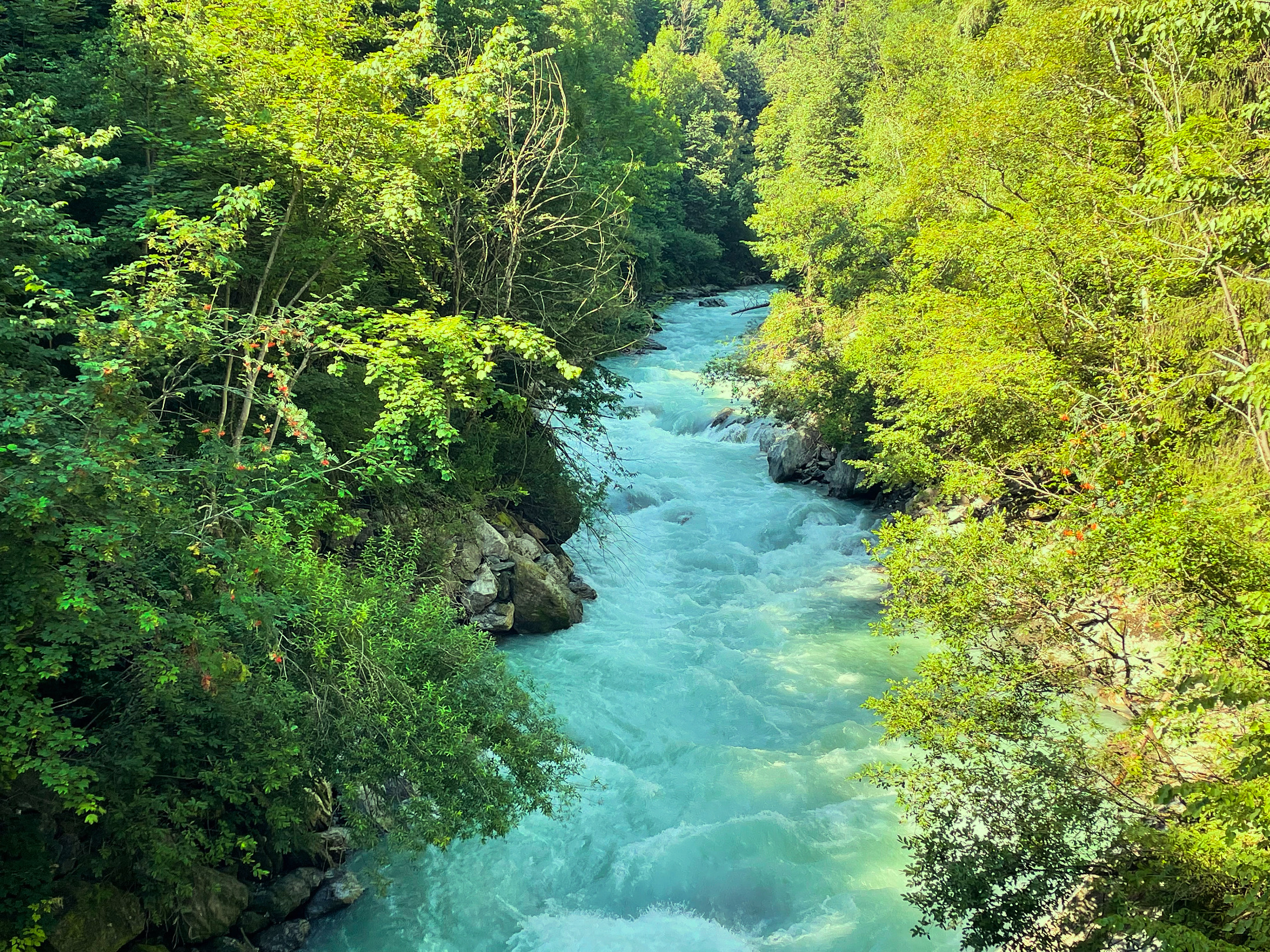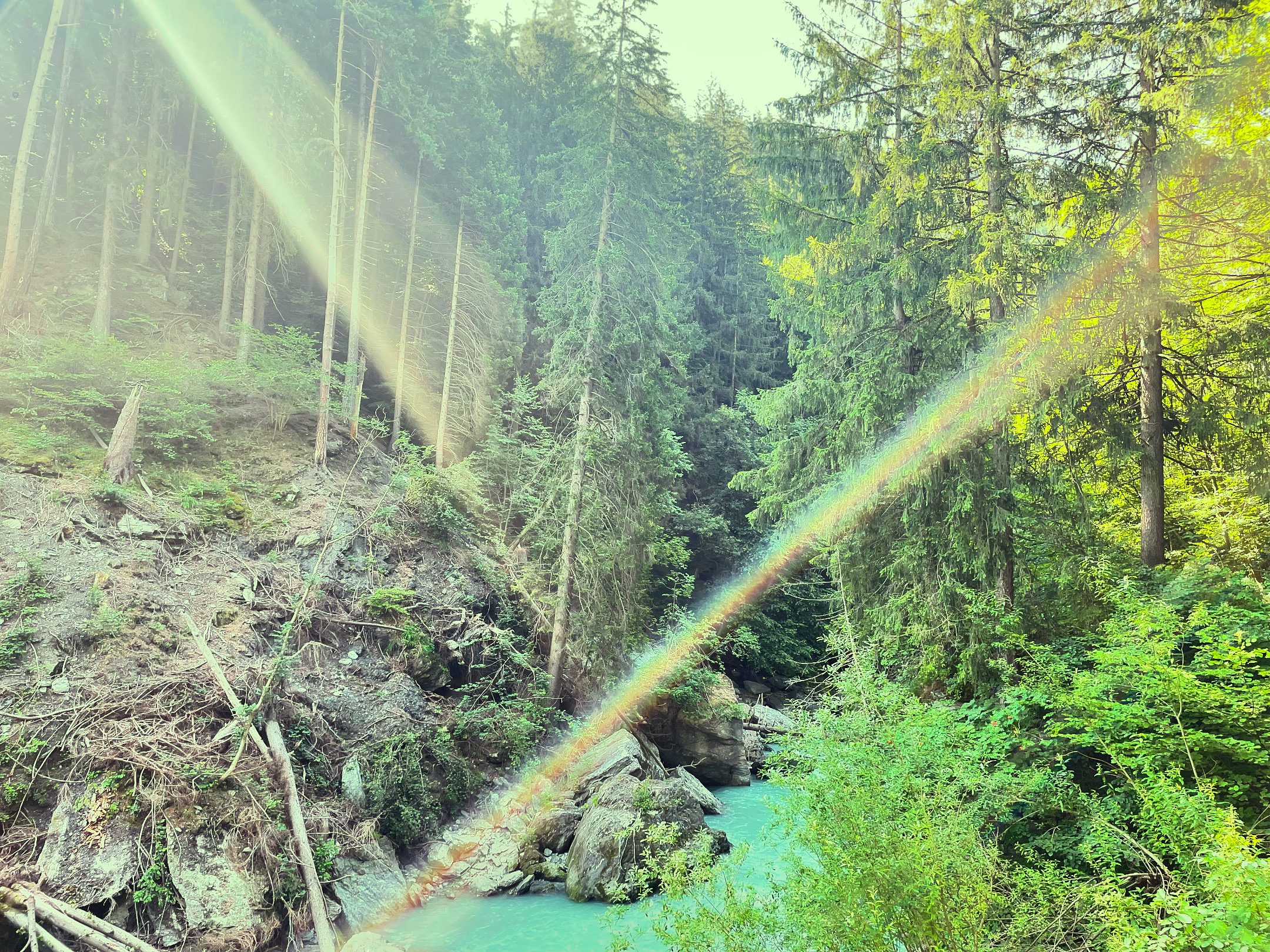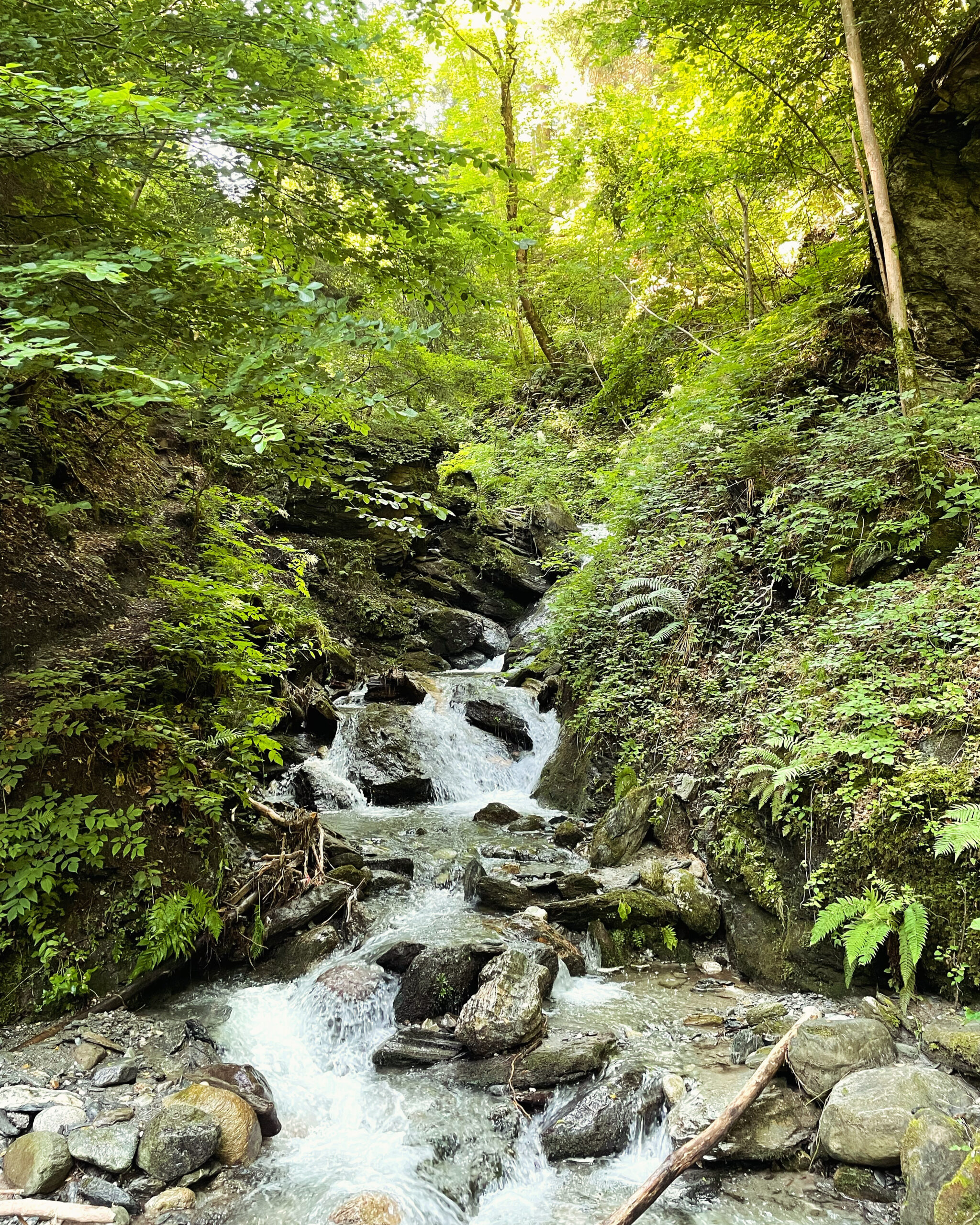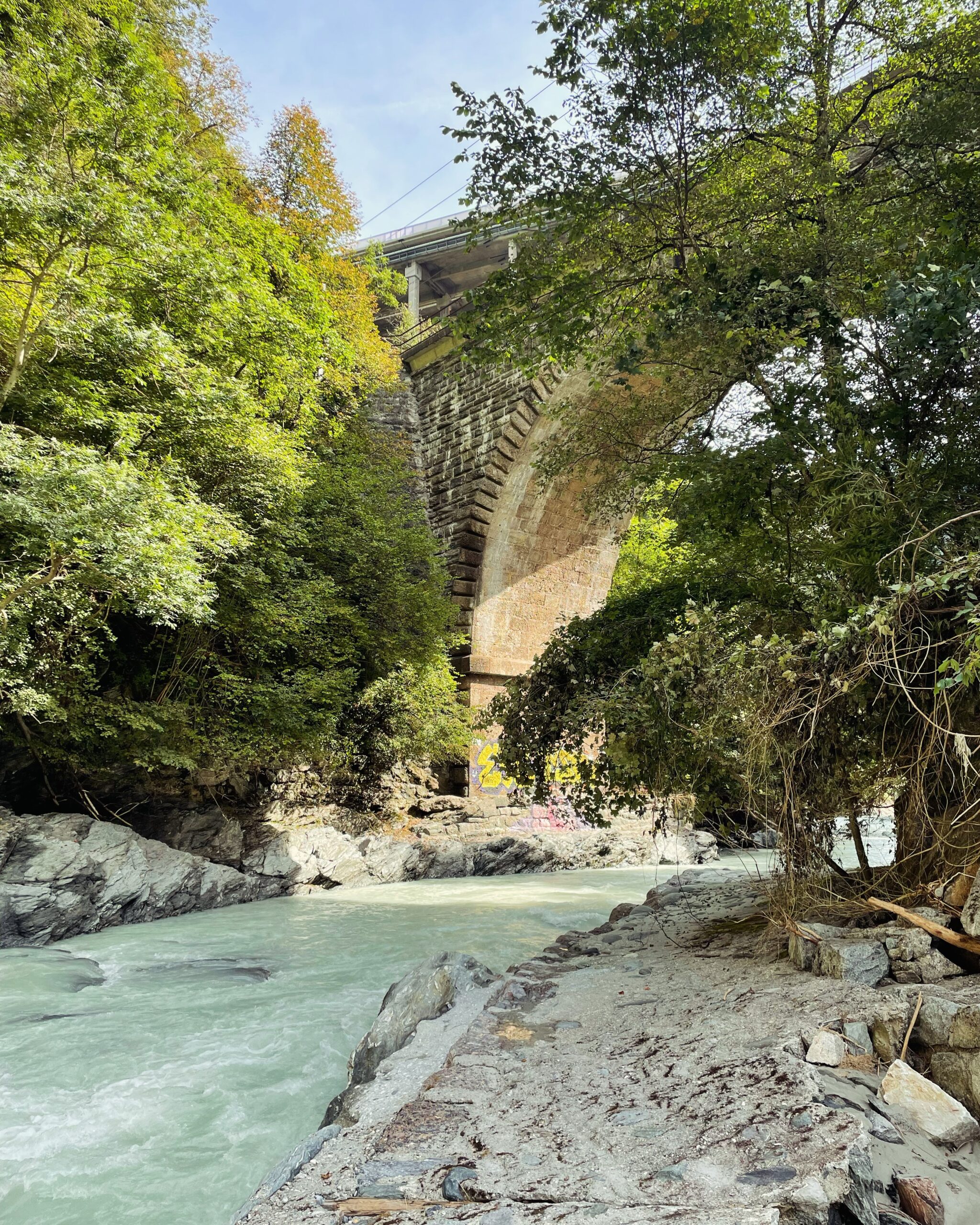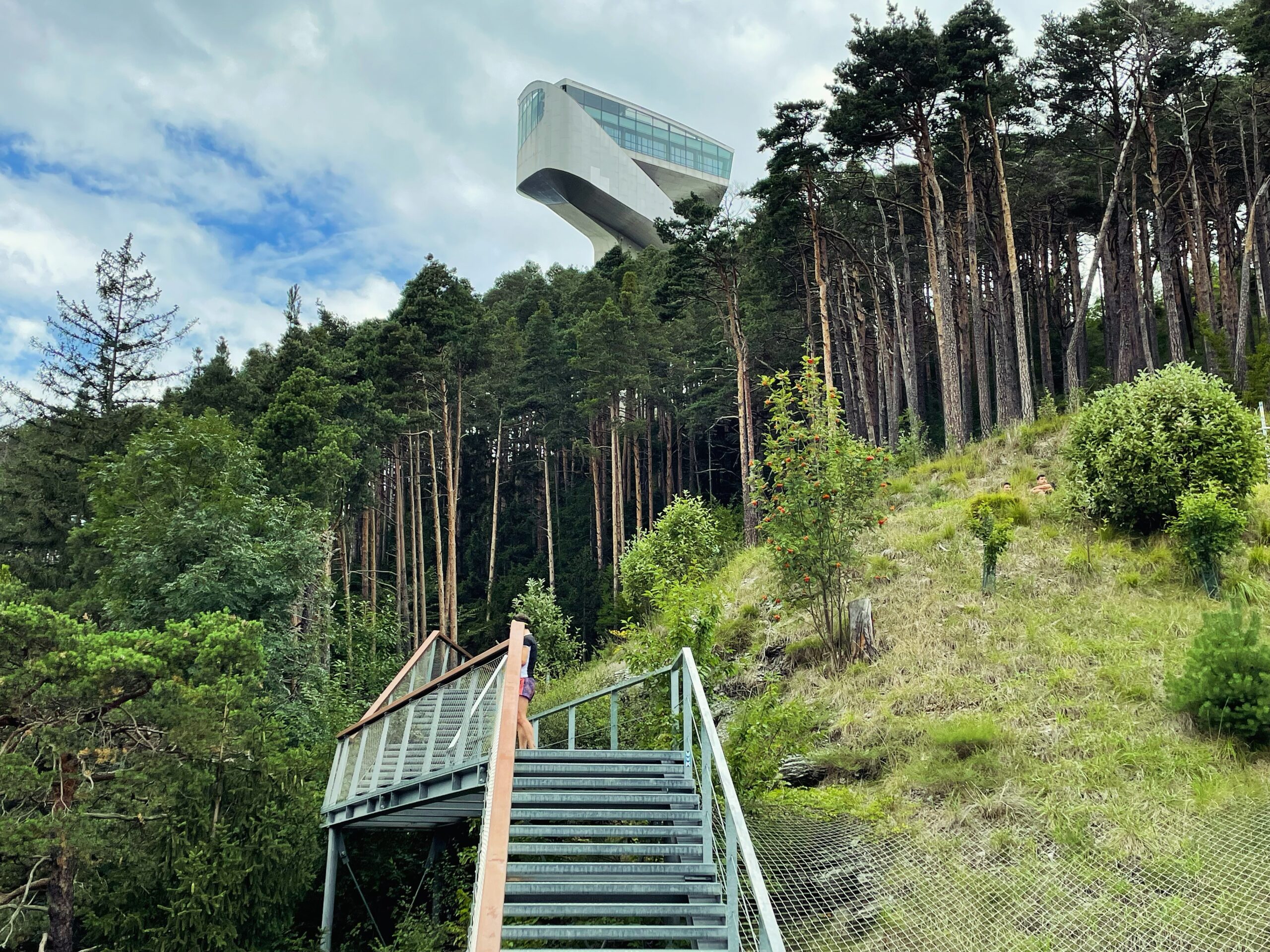Sill Gorge
Worth knowing
Just above the Brenner Pass, the Vennebach has its source at an altitude of over 2300 metres. After a short stopover next to the motorway in the Brenner lake, its ice-cold water, now under its better-known name of Sill, flows towards Innsbruck. On the way, several streams and rivers from the Alpine side valleys supply the Sill and cause it to swell to considerable dimensions. Between Gärberbach and Wilten Abbey, the river has formed a spectacular landscape. The Sill Gorge is a narrow gorge between the town, Brenner railway, main road and motorway, which not only offers peace and quiet, but also a very special flair. Hardly a ray of sunshine makes it past the trees and rocks. The mystical landscape has always been surrounded by an air of the uncanny and has been the source of many a story. Urban Legends. It all started with the dragon of the Haymonsagewhich had its nest in the Sill gorge and kept the inhabitants of Wilten on their toes with its destructive rage as early as late antiquity. In the 19th century, the Innsbruck news regularly reported horror stories from the wilderness surrounding the town. Robbers and murderers liked to hide from the authorities in the Sill Gorge. There were also forbidden meetings of socialist "agitators", missing persons, drowned people, woodworkers who had accidents, hikers who had accidents, mysterious corpses and suicides. The most gruesome crimes, however, were less mysterious and were carried out deliberately and by order. During the Nazi era, deserters were executed in the Sill Gorge. In more recent times, homeless people settled away from the town while young people met up for parties and raves without official authorisation.
Despite the creepy factor, or perhaps because of it, the Sillschlucht is one thing above all: Innsbruck's most beautiful recreational area. In summer, it offers heat-seekers cosy bathing spots, while in winter you can admire mighty icicles abseiling from the rock faces. The mild autumn sunlight colours the leaves of the mixed forest particularly beautifully. Bizarre rock formations, ivy and small waterfalls line the banks of the sometimes slow-flowing, then wildly thundering waters. Bridges and footbridges lead across the river again and again and allow beautiful views of the impressive, wildly romantic landscape. In the centre of the Sill Gorge, the Berg Isel Panorama Trail branches off, leading to the Dragon rock with its spectacular viewing platform. In the southern section, the trail becomes a narrow path that requires a little sure-footedness and appropriate footwear, but can also be walked with children without any major problems. After heavy rainfall and thunderstorms, there are frequent closures due to landslides. Shortly before Gärberbach, you walk past gardens with small weekend houses before reaching the spectacular viaduct at the end of the Sillschlucht gorge.
On one of the mighty pillars under the bridge, a bronze plaque commemorates the protracted restoration of the panoramic path. In 1907, the idea of opening up the gorge, which was difficult to access, to hikers emerged for the first time. Due to the impassability of the terrain and the bad reputation of the Sillschlucht gorge, it was to take 25 years before the Sillschluchtweg was opened up to hikers by the Innsbruck Beautification Association could be handed over to the city.
There are several places to enter the Sill Gorge. From the inn Wooden cellar a path leads past the construction site of the Brenner base tunnel to the start of the walk directly by the river. If you are travelling by car, you can park on Mount Isel and descend directly from there. A little further south, a path leads from the Sonnenburger Hof to the middle section of the Sillschlucht gorge. If you want to start the walk from the end, you can take the bus or drive to Gärberbach. Next to the plaque on the bridge, a stone by one of the green benches of the Beautification Association at the northern end of the Sill Gorge, which Schober Ruhto the chairman of the association, under whose aegis the path was created and the wild gorge tamed and opened to walkers.
Thyrsus, Haymon and the Bavarians
After the disappearance of the Western Roman Empire and its associated administration, Germanic tribes took control of the area that is now Innsbruck. Between the turn of time and the coronation of Charlemagne in the year 800, the period known as the Migration Period, Late Antiquity or the Early Middle Ages, a whole range of peoples were to be found in what is now North Tyrol. Breons, Romans, Goths, Lombards, Bavarians, Suevians and Slavs settled next to and behind each other in various areas north of the Brenner Pass. The Bavarians were able to assert themselves as a regional power in the central Inn Valley. During the land conquest, the Castell Veldidena The transition to Bavarian rule was less sudden and warlike for the Breton-Romanised population, however, and much more fluid. They were not barbarian destroyers, but groups that had been in contact with the Roman world in one form or another for centuries. Fighting was probably the exception. Cultures gradually intermingled at a time when the structure of power was rather loose. The everyday language of the people was a form of Germanic, but Latin had also established itself early on as a written language among the "barbarians" north of the Alps.
However, the most important remnant of the Romans was Christianity. The Bavarians were Christianised from the 8th century at the latest. At the time of Charlemagne (approx. 748 - 814), the Dukes of Bavaria and with them the Inn Valley became part of the Heiligen Römischen Reicheswhich extended over large parts of central Europe and northern Italy. The rulers relied on the ecclesiastical structures of the Romans to administer the territory, as clerics were often the only scribes. Instead of Roman emperors, an arrogant aristocracy ruled in the name of God over their subjects, who were agricultural labourers, as feudatories of Charles, King of the Franks, anointed by the Pope. The Christian church father Paul wrote in his Letter to the Romans laid the theological foundation for this system:
Jedermann sei untertan der Obrigkeit, die Gewalt über ihn hat. Denn es ist keine Obrigkeit außer von Gott; wo aber Obrigkeit ist, ist sie von Gott angeordnet. Darum: Wer sich der Obrigkeit widersetzt, der widerstrebt Gottes Anordnung; die ihr aber widerstreben, werden ihr Urteil empfangen. Denn die Gewalt haben, muss man nicht fürchten wegen guter, sondern wegen böser Werke. Willst du dich aber nicht fürchten vor der Obrigkeit, so tue Gutes, dann wirst du Lob von ihr erhalten. Denn sie ist Gottes Dienerin, dir zugut. Tust du aber Böses, so fürchte dich; denn sie trägt das Schwert nicht umsonst. Sie ist Gottes Dienerin und vollzieht die Strafe an dem, der Böses tut. Darum ist es notwendig, sich unterzuordnen, nicht allein um der Strafe, sondern auch um des Gewissens willen. Deshalb zahlt ihr ja auch Steuer; denn sie sind Gottes Diener, auf diesen Dienst beständig bedacht.
Culturally, Christianity also proved to be adaptable to traditions and customs in the Alpine region. The martyrs and saints of Christianity replaced the pagan polytheism. Old festivals such as the winter solstice, Thanksgiving and the beginning of spring were integrated into the Christian calendar and replaced by Christmas, All Saints' Day and Easter. Popular legends about miraculous plants, ominous mountain peaks, magical beings such as the Saligen Fräuleinenchanted kings and other legendary figures could easily be worshipped alongside Christianity.
Two of the most popular of these in Innsbruck to this day play the leading role in the founding myth of Wilten Abbey. An extraordinarily strong knight, known as the giant Haymon, travelled to Tyrol sometime between late antiquity and the early Middle Ages. In Tyrol he met the long-established giant Thyrsus von Seefeld. While the Germanic knight Haymon was armed with a sword and shield, Thyrsus, who had a Romanised name but was actually a wild inhabitant of the Alps, only had a tree trunk at his disposal. As it happened, the modern sword struck the wooden club and Haymon killed Thyrsus. In remorse for his deed, he converted to Christianity and was baptised by the Bishop of Chur. Instead of building a castle in the Inn Valley as planned, he built a monastery on the ruins of the Roman fortress of Veldidena. However, a terrifying dragon dwelled in the nearby Sill Gorge, which not only ravaged the new building of the now Christian hero every night, but also made it impossible to settle the area in any meaningful way. Haymon killed the beast, cut off its tongue and bequeathed it to his own foundation. After his career as a dragon slayer, Haymon handed over the monastery to the Benedictine monks of Tegernsee and joined the brotherhood himself as a lay brother. The people of the region were so grateful to the giant for freeing them from the dragon that they gladly placed themselves in the dutiful care of Wilten Abbey in order to cultivate the once wild land as farmers.
In this parable, Haymon stands for the initially violent but later noble and benevolent Germanic colonisers, Thyrsus for the brave and wild but ultimately defeated inhabitants of the region between the Seefeld plateau and the Brenner Pass. The dragon symbolises the evil, destructive and unchristian paganism that is eradicated by the converted Teutons. The monastery brothers, richly endowed by the brave knight, are the organising hand without which nothing would work.
The Haymonsage and their morals were just as flexible over the centuries, depending on the zeitgeist, as Christianity was when it was introduced in late antiquity. One time Haymon was a nobleman from the Rhine who came to Tyrol after the death of Charlemagne, another time he travelled between Ravenna and Germany as a follower of the Ostrogothic king Theoderic, better known as Dietrich of Bern. From the Middle Ages to the 19th century, the conversion HaymonsThe protection of peasant subjects by Christian chivalry and the founding of monasteries took centre stage in order to underpin the beneficial feudal system. In an article in the Innsbrucker Nachrichten of 2 October, on the other hand, the author Dr Franz Wöß left the Catholic element of the monastery building almost completely aside and emphasised the heroic German before turning to the healing properties of thyrsus oil, which the Seefeld farmers had been extracting from the oily slate stones since the Middle Ages. In this version of the legend, Haymon retired to the wilderness in Seefeld as a hermit after his heroic deeds instead of ending his life as a cleric in Wilten Abbey. After the Second World War, however, people wanted to distance themselves as far as possible from Germanism. The 1956 inscription on the façade of the "Inn Zum Riesen Haymon" shows the defeated Thyrsus with an Austrian coat of arms, in keeping with the victim myth of the post-war period.
The power of geography
What most visitors to Innsbruck notice first and foremost are the mountains that seem to encircle the city. The mountains are not only beautiful to look at, but have always influenced many things in the city. This starts with supposedly small things like the weather, as the writer and politician Beda Webers' view from days gone by proves:
""The warm wind or scirocco is a special phenomenon. It comes from the south, bounces off the northern mountains and falls with force into the valley. It likes to cause headaches, but it melts the winter snow quickly and promotes fertility immensely. This makes it possible to plant maize in Innsbruck""
This weather phenomenon may take its name from Scirocco and traffic was not yet a major problem in 1851. However, just like the Innsbruck car driver today, the blacksmith in the old town in 1450 and the legionnaire sent from central Italy to the Alps in 350 were certainly complaining about the warm downdraught, which seems to drive everyone crazy several times a month. In the past, people were happy about the warm air that melted the snow in the fields, whereas today's tourists moan about the apery ski slopes on the Seegrube.
The location between the Wipptal valley in the south and the Nordkette mountain range not only influences the frequency of migraines, but also the leisure activities of Innsbruck residents, as Weber also recognised. "The locals are characterised by their cheerfulness and charity, they especially love shore excursions in the beautiful season." One may talk about Kindness and benevolence The Innsbruck locals argue that excursions in the form of hiking, skiing or cycling are still very popular today. No wonder, Innsbruck is surrounded by mountains. You can be in the middle of the forest within a few minutes from anywhere in the city. Young people from all over Europe spend at least part of their time studying at the University of Innsbruck, not only because of the excellent professors and facilities, but also to spend their free time on the slopes, mountain bike routes and hiking trails without having to miss out on urban flair. This is both a blessing and a curse. As a major employer and training centre, the university boosts the economy, while at the same time the cost of living in the city, which cannot grow any further because it is squeezed between the mountains, increases due to students from abroad.
Innsbruck's rise to become the centre of Tyrol in the 15th century is also largely due to the city's location. The Brenner Pass is very low and makes it relatively easy to cross the Alpine belt that winds around Italy's northern border. In the days before the railway brought goods and people effortlessly from A to B, crossing the Alps was hard work and the Brenner Pass was a welcome relief. Between 1239 and 1303, Innsbruck was the only town between „Mellach and Ziller“ in the central Inn Valley, which had the princely right of settlement. Here, goods had to be transferred from one cart to the next within the regulated cartage system, an enormous advantage for Innsbruck's economy. Innsbruck was not quite as rich as Bolzano and had no political significance until the early 15th century, but became one of the most important transport and trade hubs in the Alpine region The former provincial capital of Merano had no chance against the city on the Inn between Brenner, Scharnitz and the Achen Pass in the long term due to its remoteness. Its location in the Alps also favoured tourism, which gained a foothold from the 1860s at the latest. Travellers appreciated the combination of easy accessibility, urban infrastructure and Alpine flair. With the development of the mountainous region by railway, it was easy to travel and spend leisure time in the mountains or at one of the spas without having to forego the comforts of city life. By the time they were tamed by the railway, the Alps had gone from being a source of problems to an economic factor. Gone were the times characterised by difficult agriculture; yesterday's enemy became a saviour.
In addition to the mountains, the rivers played a key role in Innsbruck's development. From the time of Maximilian, Innsbruck's drinking water came into the city from the Nordkette via a water pipe, while the Inn and Sill were responsible for sanitation. Cattle were led to the watering place on the Inn, laundry was washed and waste of all kinds, including human and animal faeces, was disposed of. When the town began to grow during industrialisation, the first landfill site was built at Sillspitz in the east of the town, which was later supplemented by another one in the west at what is now Sieglanger. Until the road network was improved in the 16th century, there was lively shipping traffic between Telfs, Innsbruck and Hall. Over 1000 years after the Roman colonisation, the Inn Valley was still a marshy stretch of land criss-crossed by alluvial forests. Settlements such as Wilten, castles such as the fortress above Amras and roads were built slightly away from the river on alluvial cones or in low mountain heights. The floodplains around Innsbruck were used as common land by the villages. Depending on the water level, grazing land and firewood were available and the river could be used as a transport route - or not. Field names such as At the pouring in the Höttinger Au are a reminder of the fact that until the early modern period, the Inn was not tamed either, but was more or less a cultivated wilderness. Floods were a recurring consequence of the unregulated river. Between 1749 and 1789, several floods claimed many lives in Innsbruck.
The economic damage was also immense. The Inn bridge brought customs revenue into the town's coffers and was the reason why the settlement was able to become a town. For centuries, timber was sent down the Inn from the Tyrolean Oberland as drift. In Hall, a wooden rake at the Inn bridge fished the precious flotsam out of the water. Innsbruck, but above all the salt and silver mines in Hall and Schwaz needed the material and energy source. Horse-drawn carts with over 20 animals were needed for the journey up the river, pulling goods upstream on the towpaths. Fortified ark defences were built near settlements and towns in order to tame the river at least a little and limit the impact of floods and drought.
In the 18th century, economisation and scientification, which made themselves felt in all areas of life, also promoted the cultivation of the landscape. The spirit of the Enlightenment was also applied to optimising the Inn as a transport route and increasing the economic efficiency of the available land. The common land along the Inn was increasingly placed in the care of individual landlords, who pushed ahead with the reclamation of this alluvial land. The Theresian state apparatus wanted to connect the empire not only by land with roads, but also via the main rivers. Responsibility for the regulation and construction of the Inn was transferred from the municipalities and the Hall salt works to the state. Innsbruck's first Chief ark inspector Franz Anton Rangger began mapping the Inn in 1739 in order to make the course of the river easier to plan and faster by straightening and damming it. The project of taming the river was to take more than 100 years. The Napoleonic Wars delayed the construction of the facilities. It was only after the economic hardship of the early 19th century that the state was able to continue the project. Blockstone dams gradually replaced the ark defences. By the time the Inn had been tamed, the railway had replaced shipping as a means of transport. The next major wave of engineering works on the Inn came in the second half of the 20th century. The Olympic Village, the motorway and settlements such as Sieglanger required space that had previously been withheld from the river in order to facilitate the economic miracle of the post-war period.
The smaller river that crosses Innsbruck was almost as important as the Inn. Where the Sill leaves the Sill Gorge today, the Sill Canal was created to supply the city with water. When the Counts of Andechs founded the market at the Inn bridge in 1180, the canal already existed, as the mill of Wilten Abbey in St. Bartlmä was already in operation. From here, the canal continued along the route Karmelitergasse, Adamgasse, Salurnerstraße, Meinhardstraße, Sillgasse, Ing.-Etzel-Straße to Pradler Brücke, where it reconnected with the Sill before flowing into the Inn. Initially intended primarily for fire protection, many businesses soon utilised the water flowing through the town to operate mills for power generation. It was not until the 1970s that the last parts of it disappeared after bombing damaged it during the Second World War.
The final geographical ingredient in the city's success story is the broad valley basin, which favoured Innsbruck's development. As the city grew and the population increased, so did the demand for food. While the farmers in the higher side valleys faced harsh conditions, the Inn Valley offered fertile soil and land for livestock farming and agriculture. Until the High Middle Ages, the Inn Valley was much more heavily forested. In the 13th century, as in many parts of Europe, the area around Innsbruck was subject to major and long-term human intervention in nature for economic purposes. Contrary to what is often portrayed, the Middle Ages were not a primitive time of stagnation. From the 12th century onwards, people no longer relied on prayers and God's grace to escape the effects of regularly occurring crop failures. Innovations such as three-field farming made it possible to feed the agriculturally unproductive urban population, known in modern parlance as the Overhead would call it. The reclamation of the land allowed the town to grow. The towns such as Schwaz, Hall and Innsbruck could not feed themselves, and considerable food imports were required, especially in the early modern period during the mining boom. In addition to meat, it was mainly wine that came to the county of Tyrol from abroad for a long time. Without the local farmers, however, Innsbruck would not have been able to survive. Corn, which Beda Weber considered worthy of mention in Innsbruck's cityscape as early as 1851, is still growing vigorously and even today gives large areas on the outskirts of the city an agricultural flavour.
Tourism: From Alpine summer retreat to Piefke Saga
In the 1990s, an Austrian television series caused a scandal. The Piefke Saga written by the Tyrolean author Felix Mitterer, describes the relationship between the German holidaymaker family Sattmann and their hosts in a fictitious Tyrolean holiday resort in four bizarrely amusing episodes. Despite all the scepticism about tourism in its current, sometimes extreme, excesses, it should not be forgotten that tourism was an important factor in Innsbruck and the surrounding area in the 19th century, driving the region's development in the long term, and not just economically.
The first travellers to Innsbruck were pilgrims and business people. Traders, journeymen on the road, civil servants, soldiers, entourages of aristocratic guests at court, skilled workers from various trades, miners, clerics, pilgrims and scientists were the first tourists to be drawn to the city between Italy and Germany. Travelling was expensive, dangerous and arduous. In addition, a large proportion of the subjects were not allowed to leave their own land without the permission of their landlord or abbot. Those who travelled usually did so on the cobbler's pony. Although Innsbruck's inns and innkeepers were already earning money from travellers in the Middle Ages and early modern times, there was no question of tourism as we understand it today. It began when a few crazy travellers were drawn to the mountain peaks for the first time. In addition to a growing middle class, this also required a new attitude towards the Alps. For a long time, the mountains had been a pure threat to people. It was mainly the British who set out to conquer the world's mountains after the oceans. From the late 18th century, the era of Romanticism, news of the natural beauty of the Alps spread through travelogues. The first foreign-language travel guide to Tyrol, Travells through the Rhaetian Alps by Jean Francois Beaumont was published in 1796.
In addition to the alpine attraction, it was the wild and exotic Natives Tirols, die international für Aufsehen sorgten. Der bärtige Revoluzzer namens Andreas Hofer, der es mit seinem Bauernheer geschafft hatte, Napoleons Armee in die Knie zu zwingen, erzeugte bei den Briten, den notorischen Erzfeinden der Franzosen, ebenso großes Interesse wie bei deutschen Nationalisten nördlich der Alpen, die in ihm einen frühen Protodeutschen sahen. Die Tiroler galten als unbeugsamer Menschenschlag, archetypisch und ungezähmt, ähnlich den Germanen unter Arminius, die das Imperium Romanum herausgefordert hatten. Die Beschreibungen Innsbrucks aus der Feder des Autors Beda Weber (1798 – 1858) und andere Reiseberichte in der boomenden Presselandschaft dieser Zeit trugen dazu bei, ein attraktives Bild Innsbrucks zu prägen.
Nun mussten die wilden Alpen nur noch der Masse an Touristen zugänglich gemacht werden, die zwar gerne den frühen Abenteurern auf ihren Expeditionen nacheifern wollten, deren Risikobereitschaft und Fitness mit den Wünschen nicht schritthalten konnten. Der German Alpine Club eröffnete 1869 eine Sektion Innsbruck, nachdem der 1862 Österreichische Alpenverein was not very successful. Driven by the Greater German idea of many members, the two institutions merged in 1873. Alpine Club is still bourgeois to this day, while its social democratic counterpart is the Naturfreunde. The network of paths grew as a result of its development, as did the number of huts that could accommodate guests. The transit country of Tyrol had countless mule tracks and footpaths that had existed for centuries and served as the basis for alpinism. Small inns, farms and stations along the postal routes served as accommodation. The Tyrolean theologian Franz Senn (1831 - 1884) and the writer Adolf Pichler (1819 - 1900) were instrumental in the surveying of Tyrol and the creation of maps. Contrary to popular belief, the Tyroleans were not born mountaineers, but had to be taught the skills to conquer the mountains. Until then, mountains had been one thing above all: dangerous and arduous in everyday agricultural life. Climbing them had hardly occurred to anyone before. The Alpine clubs also trained mountain guides. From the turn of the century, skiing came into fashion alongside hiking and mountaineering. There were no lifts yet, and to get up the mountains you had to use the skins that are still glued to touring skis today. It was not until the 1920s, following the construction of the cable cars on the Nordkette and Patscherkofel mountains, that a wealthy clientele was able to enjoy the modern luxury of mountain lifts while skiing.
New hotels, cafés, inns, shops and means of transport were needed to meet the needs of guests. Anyone who had running water and a telephone connection at home in London or Paris did not want to make do with an outhouse in the corridor or in front of the house when on holiday. The so-called first and second class inns were suitable for transit traffic, but they were not equipped to receive upscale tourists. Until the 19th century, innkeepers in the city and in the villages around Innsbruck belonged to the upper middle class in terms of income. They were often farmers who ran a pub on the side and sold food. As the example of Andreas Hofer shows, they also had a good reputation and influence within local society. As meeting places for the locals and hubs for postal and goods traffic, they were often well informed about what was happening in the wider world. However, as they were neither members of a guild nor counted among the middle classes, the profession of innkeeper was not one of the most honourable professions. This changed with the professionalisation of the tourism industry. Entrepreneurs such as Robert Nißl, who took over Büchsenhausen Castle in 1865 and converted it into a brewery, invested in the infrastructure. Former aristocratic residences such as Weiherburg Castle became inns and hotels. The revolution in Innsbruck did not take place on the barricades in 1848, but in tourism a few decades later, when resourceful citizens replaced the aristocracy as owners of castles such as Büchsenhausen and Weiherburg.
Opened in 1849, the Österreichischer Hof was long regarded as the top dog of the modern hotel industry, but was officially just a copy of a grand hotel. Only with the Grand Hotel Europa had opened a first-class establishment in Innsbruck in 1869. The heyday of the inns in the old town was over. In 1892, the zeitgeisty Reformhotel Habsburger Hof a second large business. Where the Metropolkino cinema stands today, the Kaiserhof was built as a new building. The Habsburg Court already offered its guests electric light, an absolute sensation. Also on the previously unused area in front of the railway station was the Arlberger Hof settled. What would be seen as a competitive disadvantage today was a selling point at the time. Railway stations were the centres of modern cities. Station squares were not overcrowded transport hubs as they are today, but sophisticated and well-kept places in front of the architecturally sophisticated halls where the trains arrived.
The number of guests increased slowly but steadily. Shortly before the outbreak of the First World War, Innsbruck had 200,000 guests. In June 1896, the Innsbrucker Nachrichten:
„Der Fremdenverkehr in Innsbruck bezifferte sich im Monat Mai auf 5647 Personen. Darunter befanden sich (außer 2763 Reisenden aus Oesterreich-Ungarn) 1974 Reichsdeutsche, 282 Engländer, 65 Italiener, 68 Franzosen, 53 Amerikaner, 51 Russen und 388 Personen aus verschiedenen anderen Ländern.“
In addition to the number of travellers who had an impact on life in the small town of Innsbruck, it was also the internationality of the visitors who gradually gave Innsbruck a new look. In addition to the purely touristic infrastructure, the development of general innovations was also accelerated. The wealthy guests could hardly socialise in pubs with cesspits behind their houses. Of course, a sewerage system would have been on the agenda anyway, but the economic factor of tourism made it possible and accelerated the release of funds for the major projects at the turn of the century. This not only changed the appearance of the town, but also people's everyday and working lives. Resourceful entrepreneurs such as Heinrich Menardi managed to expand the value chain to include paid holiday pleasures in addition to board and lodging. In 1880, he opened the Lohnkutscherei und Autovermietung Heinrich Menardi for excursions in the Alpine surroundings. Initially with carriages, and after the First World War with coaches and cars, wealthy tourists were chauffeured as far as Venice. The company still exists today and is now based in the Menardihaus at Wilhelm-Greil-Strasse 17 opposite Landhausplatz, even though over time the transport and trading industry shifted to the more lucrative property sector. Local trade also benefited from the wealthy clientele from abroad. In 1909, there were already three dedicated Tourist equipment shops next to the fashionable department stores that had just opened a few years earlier.
Innsbruck and the surrounding towns were also known for spa holidays, the predecessor of today's wellness, where well-heeled clients recovered from a wide variety of illnesses in an Alpine environment. The Igler Hof, back then Grandhotel Igler Hof and the Sporthotel Igls, still partly exude the chic of that time. Michael Obexer, the founder of the spa town of Igls and owner of the Grand Hotel, was a tourism pioneer. There were two spas in Egerdach near Amras and in Mühlau. The facilities were not as well-known as the hotspots of the time in Bad Ischl, Marienbad or Baden near Vienna, as can be seen on old photos and postcards, but the treatments with brine, steam, gymnastics and even magnetism were in line with the standards of the time, some of which are still popular with spa and wellness holidaymakers today. Bad Egerdach near Innsbruck had been known as a healing spring since the 17th century. The spring was said to cure gout, skin diseases, anaemia and even the nervous disorder known in the 19th century as neurasthenia, the predecessor of burnout. The institution's chapel still exists today opposite the SOS Children's Village. The bathing establishment in Mühlau has existed since 1768 and was converted into an inn and spa in the style of the time in the course of the 19th century. The former bathing establishment is now a residential building worth seeing in Anton-Rauch-Straße. However, the most spectacular tourist project that Innsbruck ever experienced was probably Hoch Innsbruck, today's Hungerburg. Not only the Hungerburg railway and hotels, but even its own lake was created here after the turn of the century to attract guests.
One of the former owners of the land of the Hungerburg and Innsbruck tourism pioneer, Richard von Attlmayr, was significantly involved in the predecessor of today's tourism association. Since 1881, the Innsbruck Beautification Association to satisfy the increasing needs of guests. The association took care of the construction of hiking and walking trails, the installation of benches and the development of impassable areas such as the Mühlauer Klamm or the Sillschlucht gorge. The striking green benches along many paths are a reminder of the still existing association. 1888 years later, the profiteers of tourism in Innsbruck founded the Commission for the promotion of tourismthe predecessor of today's tourism association. By joining forces in advertising and quality assurance at the accommodation establishments, the individual businesses hoped to further boost tourism.
„Alljährlich mehrt sich die Zahl der überseeischen Pilger, die unser Land und dessen gletscherbekrönte Berge zum Verdrusse unserer freundnachbarlichen Schweizer besuchen und manch klingenden Dollar zurücklassen. Die Engländer fangen an Tirol ebenso interessant zu finden wie die Schweiz, die Zahl der Franzosen und Niederländer, die den Sommer bei uns zubringen, mehrt sich von Jahr zu Jahr.“
Postkarten waren die ersten massentauglichen Influencer der Tourismusgeschichte. Viele Betriebe ließen ihre eigenen Postkarten drucken. Verlage produzierten unzählige Sujets der beliebtesten Sehenswürdigkeiten der Stadt. Es ist interessant zu sehen, was damals als sehenswert galt und auf den Karten abgebildet wurde. Anders als heute waren es vor allem die zeitgenössisch modernen Errungenschaften der Stadt: der Leopoldbrunnen, das Stadtcafé beim Theater, die Kettenbrücke, die Zahnradbahn auf die Hungerburg oder die 1845 eröffnete Stefansbrücke an der Brennerstraße, die als Steinbogen aus Quadern die Sill überquerte, waren die Attraktionen. Auch Andreas Hofer war ein gut funktionierendes Testimonial auf den Postkarten: Der Gasthof Schupfen in dem Andreas Hofer sein Hauptquartier hatte und der Berg Isel mit dem großen Andreas-Hofer-Denkmal waren gerne abgebildete Motive.
1914 gab es in Innsbruck 17 Hotels, die Gäste anlockten. Dazu kamen die Sommer- und Winterfrischler in Igls und dem Stubaital. Der Erste Weltkrieg ließ die erste touristische Welle mit einem Streich versanden. Gerade als sich der Fremdenverkehr Ende der 1920er Jahre langsam wieder erholt hatte, kamen mit der Wirtschaftskrise und Hitlers 1000 Mark blockThe next setback came in 1933, when he tried to put pressure on the Austrian government to end the ban on the NSDAP.
It required the Economic miracle in the 1950s and 1960s to revitalise tourism in Innsbruck after the destruction. Between 1955 and 1972, the number of overnight stays in Tyrol increased fivefold. After the arduous war years and the reconstruction of the European economy, Tyrol and Innsbruck were able to slowly but steadily establish tourism as a stable source of income, even away from the official hotels and guesthouses. Many Innsbruck families moved together in their already cramped flats to supplement their household budgets by renting out beds to guests from abroad. Tourism not only brought in foreign currency, but also enabled the locals to create a new image of themselves both internally and externally. At the same time, the economic upturn made it possible for more and more Innsbruck residents to go on holiday abroad. The beaches of Italy were particularly popular. The wartime enemies of previous decades became guests and hosts.
Article: Exhibited relief
Published: Innsbrucker Nachrichten / 10 May 1907
For some time now, a relief modelled and coloured by the teacher Karl Hausleitner has been on display in the window of Wagner's bookshop for general viewing, clearly illustrating the layout of the Innsbruck Beautification Association on the southern and south-western slopes of the Innsbruck Abbey, the Bieler Weg, as well as its continuation to the eastern slopes and up to Sonnenburgerhofstraße, especially the path dedicated to Dr. Richard Wirth. The mountain slope at the Sonnenburgerhof in particular, like a serpentine, descends at such a gradient along the Schloßhof and Fürstenweg that it will be a marvellous forest promenade in summer and a road for tobogganing in winter. The work will be carried out in accordance with the subscriptions received and under the direction of Mr Riehl, an engineer interested in the construction, and this name vouches for the practicality and good workmanship. In the future, the path is to be extended over the Isel mountain to the Sill gorge. The Wagner'sche Universitäts-Buchhandlung has already made a number of donations towards this path. Walkers who are among the best supporters of these charitable endeavours of the Verschönerungsverein will be pleased to sponsor the work.
Article: Rossa Peer
Published: Innsbrucker Nachrichten / 8 May 1879
It can now be assumed with complete certainty that Rossa Peer von Igls was not the victim of any crime, but that she had an accident; in order to shorten the route as much as possible, she seems to have taken the path that has become dangerous as a result of uninterrupted deforestation, which leads up to the quarry at the entrance to the Sill gorge, and to have fallen; for above the place where the body was found, the path is such that it must always be passed with the greatest care, and remains dangerous at all times, especially in twilight. It would be very desirable if this footpath were made completely impracticable.
